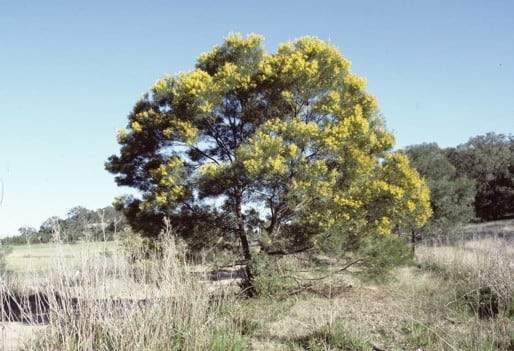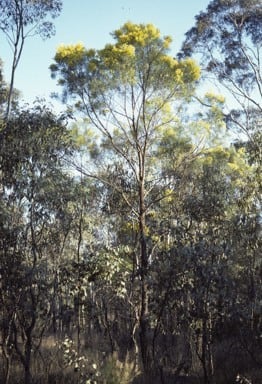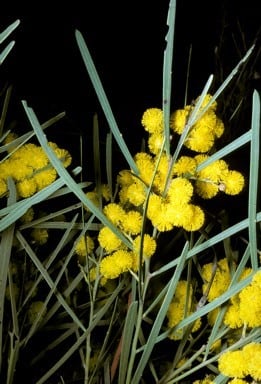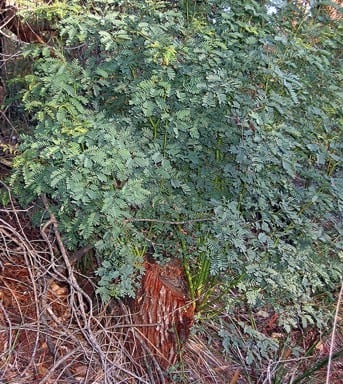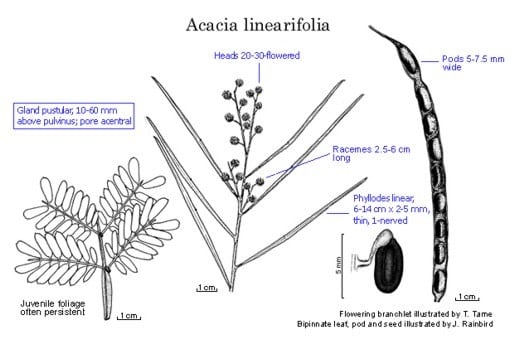Acacia linearifolia Maiden & Blakely
WATTLE
Acacias of Australia
Common Name
Stringybark Wattle, Narrow-leaved Wattle
Family
Fabaceae
Distribution
Occurs principally from Scone–Denman W to Gulgong–Dunedoo, with southern outliers at Binalong, Wagga Wagga and The Rock (c. 300–400 km SSW of Gulgong), N.S.W.
Description
Shrub or tree to c. 10 m high; juvenile bipinnate foliage may persist on lower branches. Branchlets dark reddish, glabrous, sometimes scurfy. Phyllodes narrowly linear, 6–14 cm long, (1–) 2–5 mm wide, apices recurved-mucronate to uncinate, thin, smooth, green to greyish green, glabrous, 1-nerved; lateral nerves absent or obscure; glands pustular, occasionally 2, with lowermost 1–6 cm above pulvinus. Inflorescences racemose; raceme axes normally 2.5–6 cm long, glabrous; heads globular, rather densely 20–30-flowered, golden; peduncles 2–4 mm long, glabrous. Flowers 5-merous; sepals united. Pods raised on opposite sides over alternate seeds, normally shallowly constricted between seeds, to c. 12 cm long, 5–7.5 mm wide, firmly chartaceous to thinly coriaceous, reddish brown, glabrous. Seeds longitudinal, oblong to elliptic, 5–6 mm long, shiny, black; funicle short; aril clavate.
Habitat
Grows commonly in colluvial sand on lower slopes of sandstone hills.
Specimens
N.S.W.: Binalong, Oct. 1956, H.Boyd s.n. (NSW); 28.4 km c. W from Muswellbrook on the road to Sandy Hollow, R.Coveny 2412 (BRI, NSW, PERTH); The Rock, 14 Mar. 1929, B.Dwyer s.n. (NSW); 59 km from Mudgee towards Cassilis, M.E.Phillips 312 (CANB, L n.v.).
Notes
Information on the biological and ecological features, and the utilisation potential, of this species is given in B.R.Maslin and M.W.McDonald, AcaciaSearch: Evaluation of Acacia as a woody crop option for southern Australia, RIRDC Publication No. 03/017, 114–117 (2004).
The complex nomenclatural history of A. linearifolia is discussed by B.R.Maslin, Telopea 6: 43–49 (1994). The species has often been confounded with the more northerly distributed A. adunca which is distinguished especially by its commonly narrower phyllodes, less prominent glands, fewer and less densely congested flowers in the heads and broader pods which are not or scarcely constricted between the seeds. Phyllodes may resemble those of A. macnuttiana and A. forsythii, but neither of these species have the prominent foliar glands of A. linearifolia. Appears to be very closely related to A. pustula (Qld) which is distinguished primarily by its glands which tend to be slightly larger (1–1.5 mm long), commonly connected to the midrib by a fine, oblique nerve and have a large, central pore; in A. linearifolia the glands are 0.5–0.7 (–1) mm long, infrequently connected to midrib by a nerve and normally have a small, acentral pore.
FOA Reference
Data derived from Flora of Australia Volumes 11A (2001), 11B (2001) and 12 (1998), products of ABRS, ©Commonwealth of Australia
Author
Minor edits by B.R.Maslin & J.Rogers
B.R.Maslin
This identification key and fact sheets are available as a mobile application:
URL: https://apps.lucidcentral.org/wattle/
© Copyright 2018. All rights reserved.
